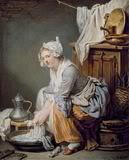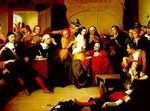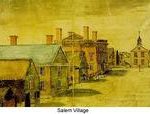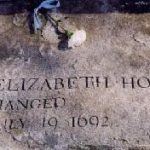The Witch of Hampton
New Englanders in the seventeenth century feared the devil above all else. They believed that natural disasters were caused by a person who was possessed by Old Nick. If their crops failed, if a cow went dry, or if an epidemic struck, they blamed someone in the community, usually an eccentric old person.
William and Eunice Cole first came to New Hampshire as indentured servants from London, England in 1638. They became part of a new colony at Exeter that was being established under the leadership of Reverend John Wheelwright. In 1640, the Coles decided to move to the settlement at nearby Hampton. Wheelwright moved from Exeter to Wells, Maine, but was ousted from there and made a bid for control of Hampton. That left the Coles back under the jurisdiction of the leader they had previously abandoned.
For years, the people of Hampton worried and gossiped about their neighbor, Goodwife Eunice Cole. (Goodwife, usually abbreviated Goody, was a polite form of address for women of lower social standing in the 1600s.) On at least three occasions, her neighbors brought her to court for conduct indicating witchcraft, or as it was called, familiarity with the Devil.
The Coles were poor and elderly, but they owned forty acres of valuable land near the salt marshes that was highly desired by others. Maybe that was the beginning of Goody’s problems. She was depicted as an unsympathetic character, because she stood up for her rights in an era when women had none.
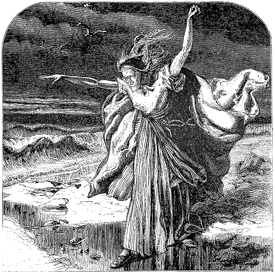
Goody’s Alleged Crimes
Neighborhood children claimed they had seen her take the form of a dog, a cat, and an eagle. They said they had seen the devil, in the form of a black dwarf with a red cap, sitting at her table.
A man whose cattle had eaten grass on Goody’s property claimed that she had put a curse on them. One of his calves died, and another disappeared. She was also blamed for the loss of a fishing boat with all aboard.
The townspeople were convinced of Goody’s guilt. The county judge, after hearing all of the evidence, sentenced her to life imprisonment. She was sixty-four years old at the time. After being condemned as the Witch of Hampton in 1656, Goody Cole was confined to a bleak, cold Boston jail cell for much of her last twenty years. When her eighty-eight year-old husband William complained that he couldn’t manage his affairs without his wife’s help, the court sold his land and paid his debts from the receipts.
Eunice Cole petitioned several times for her release from jail so she could go home and care for her husband. Finally, in 1671, after fifteen years, she was allowed to return to Hampton, where she learned that her husband had died.
The Boston court billed the town of Hampton for the cost of her board while she was in prison. When the town defaulted after two years of payment, Goody’s former jailor arrested one of the selectmen. The town fathers demanded that the citizens of Hampton who hated and feared her provide for her care. Each week a different family was required to bring her food and fuel, or else pay the value of four shillings. One day, according to Joseph Dow’s History of Hampton, the smoke stopped coming from her chimney, and the food stayed unclaimed at her door.
Theories Abound
Eunice Cole died alone in a small hut off Rand’s Hill in Hampton the age of eighty-eight. Exactly where she was buried is unknown. It is said that a mob carried her body to a field and drove a stake through her heart, the only sure way, they believed, to exorcise the devil.
One theory is that the local citizens tossed her body in a nearby ditch. Another says they threw her off a cliff into the sea. Or, maybe she was buried on the land that had once been her 40-acre farm, the same property the town of Hampton took from Goody to pay the cost of confining her in that lonely Boston cell.
In all versions of the legend, the fair citizens of colonial Hampton discovered the body of the witch, and drove a wooden stake into her heart, then hung a horseshoe on the stake to protect themselves from retribution.
No history of the region fails to mention Goodwife Cole, but it was John Greenleaf Whittier who immortalized her in 1864 with his poems, The Changeling and Wreck of the Rivermouth. In those passages, Goody transforms a baby into a demon and causes the shipwreck that resulted in the deaths of eight Hampton residents.
In 1908, a Hampton man reported that since building his house on the site of the Coles’ hut he had had nothing but bad luck. He was sure the spirit of Goody Cole still cursed the place. Moreover, he said, the knowledge that she might be buried on his property made him very nervous.
When Hampton celebrated its tercentenary in 1938, a group was formed for the sole purpose of redressing the wrongs done to her. The group was called “The Society in Hampton for the Apprehension of Those Falsely Accusing Eunice ‘Goody’ Cole of Having Had Familiarity With the Devil.”
A ceremony was held to exonerate Eunice Cole, and her name was officially cleared of all charges of witchcraft. Replicas of her trial documents were burned as a form of apology. The ashes were mixed with soil from the old Cole farm, then stored in an urn in the Tuck Museum as a reminder of this tragic story.
Through the years, Hampton residents have told stories of seeing a mysterious old woman wandering the streets. Once a policeman, on encountering a shawl-covered old woman, warned her to be careful walking on the heavily-traveled roads of Hampton. “I guess I’ll get along all right,” she replied. “I’ve been walking along these roads for hundreds of years.” He later realized that she was no ordinary wanderer.
In 1963, the city erected a large erosion stone outside the Tuck Museum, which sits on the presumed site of Goody and William Cole’s farm.
SOURCES
Eunice Goody Cole
Eunice Cole, Hampton’s Witch
The Hexploitation of Goody Cole
BUY THE BOOK AT AMAZON:


